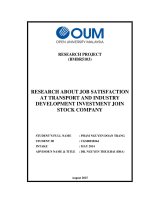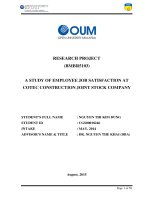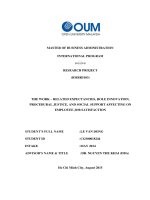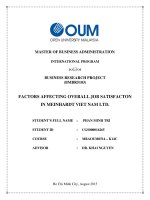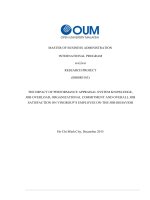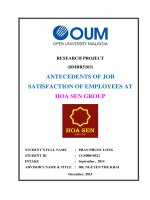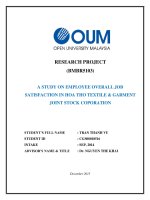Research about overall job satisfaction at hoa sen group
Bạn đang xem bản rút gọn của tài liệu. Xem và tải ngay bản đầy đủ của tài liệu tại đây (1.24 MB, 66 trang )
MASTER OF BUSINESS ADMINISTRATION
INTERNATIONAL PROGRAM
RESEARCH PROJECT
(BMBR5103)
RESEARCH ABOUT OVERALL JOB
SATISFACTION AT HOA SEN GROUP
STUDENT’S FULL NAME
: LE MINH QUAN
STUDENT ID
: CGS00019377
INTAKE
: MARCH 2015
ADVISOR’S NAME & TITLE
: NGUYEN THE KHAI (DBA)
Ho Chi Minh City,July 2016
ADVISOR’S ASSESSMENT
..…………………………………………………………………………………………………………
..…………………………………………………………………………………………………………
..…………………………………………………………………………………………………………
..…………………………………………………………………………………………………………
..…………………………………………………………………………………………………………
..…………………………………………………………………………………………………………
..…………………………………………………………………………………………………………
..…………………………………………………………………………………………………………
..…………………………………………………………………………………………………………
..…………………………………………………………………………………………………………
..…………………………………………………………………………………………………………
..…………………………………………………………………………………………………………
ADVISOR’S SIGNATURE
..…………………………………………………………………………………………………………
..…………………………………………………………………………………………………………
..…………………………………………………………………………………………………………
NGUYEN THE KHAI (DBA)
..…………………………………………………………………………………………………………
ACKNOWLEDGMENT
S
After studying at Hutech I have gained a lot of valuable knowledge from the
teacher to be able to complete this topic, and well on her chosen path. The first
word I would like to thank administrators, teachers taught you in international
training institutes a most sincere thank you to the teachers directly teach, mentor
and impart to you is professional knowledge while studying in the school.
I would like to express my deepest gratitude to Dr. KHAI NGUYEN (DBA),
who instructed, gave me a chance and inspired me to do this research. I also would
like to express my thanks to my colleagues who helped me with very useful
information to do this assignment. Thanks all employees of Hoa Sen Goup for
their precious comments and helps to collect data for this research.
And, I also specially thank to my members of family, friends and colleagues
always mobilize me to finish this research.
Thank you very much,
HCMC, July 2016
CONTENTS
ABSTRACT -------------------------------------------------------------------------------------- 1
PART I. INTRODUCTION -------------------------------------------------------------------- 2
1.1. About Hoa Sen Group ----------------------------------------------------------------------2
1.2. Research objective-------------------------------------------------------------------------- 7
1.3. Object and Scope of Research ------------------------------------------------------------ 8
1.4. Research Methods -------------------------------------------------------------------------- 8
1.5. Research problem statement -------------------------------------------------------------- 9
1.6. Structure of research ----------------------------------------------------------------------- 9
PART II. LITERATURE REVIEW ---------------------------------------------------------- 10
2.1. Definition of Constructs ------------------------------------------------------------------ 10
Overall Job Satisfaction ------------------------------------------------------------------- 10
Goal and Process Clarity ------------------------------------------------------------------ 12
Work Control -------------------------------------------------------------------------------- l3
Supervisor Support ------------------------------------------------------------------------- 14
Performance Appraisal System Knowledge -------------------------------------------- 15
2.2. Argument for the relationship among the constructs --------------------------------- 16
The Goal and Process Clarity and Overall Job Satisfaction ------------------------- 16
The relationship between Work Control and Overall Job Satisfaction ------------- 18
The relationship between Supervisor Support and Overall Job Satisfaction ------ 19
The relationship between Performance Appraisal System Knowledge and Overall
Job Satisfaction ---------------------------------------------------------------------------- 21
2.3. Hypotheses and Research model -------------------------------------------------------- 24
Hypothese ---------------------------------------------------------------------------------- 24
Research model ---------------------------------------------------------------------------- 24
Concept of Research Model -------------------------------------------------------------- 25
PART III. RESEARCH METHODS ---------------------------------------------------------26
3.1. Research design ----------------------------------------------------------------------------26
3.2. Desgin template scale ---------------------------------------------------------------------25
3.3. Data collection progress ------------------------------------------------------------------31
3.4. Data Analysis ------------------------------------------------------------------------------32
PART IV. ANALYSIS RESULT-------------------------------------------------------------34
4.1. Reliability statistic -------------------------------------------------------------------------34
4.2. Descriptive statistic------------------------------------------------------------------------35
4.3. Correlation statistic ------------------------------------------------------------------------35
4.4. Hypotheses Testing Results --------------------------------------------------------------36
Hypothesis 1 Testing Result -----------------------------------------------------------36
Hypothesis 2 Testing Result -----------------------------------------------------------38
Hypothesis 3 Testing Result -----------------------------------------------------------39
Hypothesis 4 Testing Result -----------------------------------------------------------40
PART V. CONCLUSION ---------------------------------------------------------------------42
5.1. The result and discussion ----------------------------------------------------------------42
5.2. The Limitation of research --------------------------------------------------------------44
5.3. Recommendation -------------------------------------------------------------------------44
REFERENCES ----------------------------------------------------------------------------------46
APPENDIX --------------------------------------------------------------------------------------50
Appendix 1: Survey Questionnaires----------------------------------------------------------50
Appendix 2: Presentation Slides --------------------------------------------------------------56
FIGURE AND TABLE
LIST FIGURE
Figure 1: Hoa Sen Group Head Office ----------------------------------------------------------------- 2
Figure 2: Organization structure ------------------------------------------------------------------------ 4
Figure 3: Ownership structure--------------------------------------------------------------------------- 5
Figure 4: Training and HR development -------------------------------------------------------------- 6
Figure 5: Training activities ----------------------------------------------------------------------------- 7
Figure 6: Research model ------------------------------------------------------------------------------- 24
Figure 7: Concept of Reasearch model --------------------------------------------------------------- 25
LIST TABLE
Table 1: Goal and Process Clarity questionnaire ---------------------------------------------------- 27
Table 2: Work Control questionnaire ----------------------------------------------------------------- 28
Table 3: Supervisor Support questionnaire ----------------------------------------------------------- 29
Table 4: Performance Appraisal System Knowledge questionnaire ------------------------------ 30
Table 5: Overall Job satisfaction questionnaire------------------------------------------------------ 31
Table 6: Time table for sending, receiving and checking survey --------------------------------- 32
Table 7: Reliability statistics --------------------------------------------------------------------------- 34
Table 8: Descriptive statistic --------------------------------------------------------------------------- 35
Table 9: Correlations ------------------------------------------------------------------------------------ 36
Table 10: Model Summary (H1) ----------------------------------------------------------------------- 37
Table 11: Coefficientsa (H1) --------------------------------------------------------------------------- 37
Table 12: Model Summary (H2) ----------------------------------------------------------------------- 38
Table 13: Coefficientsa (H2) --------------------------------------------------------------------------- 38
Table 14: Model Summary (H3) ---------------------------------------------------------------------- 39
Table 15: Coefficientsa (H3) --------------------------------------------------------------------------- 39
Table 16: Model Summary (H4) ----------------------------------------------------------------------- 40
Table 17: Coefficientsa (H4) --------------------------------------------------------------------------- 41
Business Research Methods
P a g e 1 / 57
ABSTRACT
This research aimed to identify the factors that impact the satisfaction among
staff working at Hoa Sen Group. The research results indicated four groups of
factors (variables) which had impacted on these on these staff’s satisfaction namely
Goal and Process Clarity (GPC), Work Control (WC), Supervisor Support (SS), and
Performance Appraisal System Knowledge (PASK) on Overall Job Satisfaction
(OJS) in Hoa Sen Group . Practical data were collected from 256 employees out of
300 employees in the company by means of a questionnaire. Statistical techniques
such as descriptive statistics, correlation and linear regression were employed. The
results of the study indicated a positive significant relationship between Supervisor
Support, Goal and Process Clarity and Overall Job Satisfaction.
Empirical results also indicated that the Work Control were having slightly
impact on Overall Job Satisfaction, while, Performance Appraisal System
Knowledge was not having significant impact on Overall Job Satisfaction. The
results can provide the reference for Management Team about the relationship
between Goal and Process Clarity (GPC), Work Control (WC), Supervisor Support
(SS), and Performance Appraisal System Knowledge (PASK) on Overall Job
Satisfaction (OJS) in Hoa Sen Group.
I hope results of this research will help the CEO; managers of Hoa Sen group
have some reference angle in human resource management to improve and increase
our quality resource based on job satisfaction of employees as well as you should
have perception clearly that job satisfaction of employees will impact to working
effective, ability of competitiveness of the company on Vietnam market
Key Words: Goal and Process Clarity (GPC), Work Control (WC), Supervisor
Support (SS), Performance Appraisal System Knowledge (PASK), Overall Job
Satisfaction (OJS)
Student: Le Minh Quan (ID: CGS00019377)
Business Research Methods
P a g e 2 / 57
PART I. INTRODUCTION
1.1.
About Hoa Sen Group
General introduction
Hoa Sen Group Joint Stock Company (HSG) was established in 2001. In
2007, HSG changed to operate as Group model. The Company has two main
business divisions including steel products and construction materials, port
operation and logistics. In construction materials business, it mainly manufactures
cold-rolled steel, coated steel alloys and other specialized steel products for
construction; including production of plastic-based construction materials. Its
assembly line applies the most advanced technology of Japan with effective
capacity. The company's products are distributed to 82 subsidiaries and more than
10,000 agents. In the current, the company has got big market share of steel
manufacture and consumption being 21%. In the ending of March 2015, total
chartered capital is VND1008 billion. In the end of 2015, the company has 130
subsidiaries and about 10,000 stores. Through Nov 2014: The company retained the
No.1 market share of galvanized steel sheet and No.2 of steel pipe.
Figure 1: Hoa Sen Group Head Office
History
On Aug 8, 2001: The company originated from Hoa Sen Joint Stock
Company was established with the initial chartered capital of VND30 billion.
Student: Le Minh Quan (ID: CGS00019377)
Business Research Methods
P a g e 3 / 57
On Mar 16, 2007: The company increased their chartered capital to
VND400 billion and renamed to Hoa Sen Group.
On Nov 8, 2007: The company renamed as Hoa Sen Group Joint Stock
Company.
In Dec 2007: The company merged with their subsidiaries including Hoa
Sen Tole Joint Stock Company, Hoa Sen Construction Material Joint Stock
Company, Hoa Sen Mechanics and Construction Joint Stock Company.
On Nov 5, 2008: The company listed on HOSE with the chartered capital
of VND570 billion.
In 2011: The company inaugurated Phrase 1 in Project of the Phu My
Hoa Sen Tole factory, established 13 more retail branches, increased the total
branch to 106 branches.
In 2012: The company's export revenue reached USD180 million,
became the leading glid tole exporter in South East Asia.
Until March 2015, the company's chartered capital is VND1008 billion.
Industry
Manufacturing of cold-rolled steel, coated steel alloys and other
specialized steel products for construction; manufacturing of black, coatedzinc steel pipes and others.
Manufacturing of steel, zinc cell.
Manufacturing of coated steel net, coated-zinc steel wire, and other steel
wires.
Manufacturing of PVC ceiling board.
Manufacturing of construction material.
Trading construction materials and consumption goods.
Vision and mission
Vision: Become a leading economic group in building material field in Vietnam
and in the region with a sustainable development strategy that focuses on traditional
products such as coated steel sheet, steel, plastic and is based on building and
Student: Le Minh Quan (ID: CGS00019377)
Business Research Methods
P a g e 4 / 57
developing core competitive advantages: vertically integrated value chain;
distribution - retail network; strong, friendly and community - oriented brand;
unique governance system and corporate culture as well as pioneering in
technological innovation investment in order to maximize added value for
shareholders, employees and society.
Mission: Provide products with international quality and reasonable prices under
the Hoa Sen brand in order to meet customers’ needs and contribute to changing the
country’s architectural landscape and developing the community.
Organization structure
Figure 2: Organization structure
Student: Le Minh Quan (ID: CGS00019377)
Business Research Methods
P a g e 5 / 57
Ownership structure
Figure 3: Ownership structure
Contact information
Name of Corporation : HOA SEN GROUP
Headquarters: No.09, Thong Nhat Boulevard, Song Than 2 Industrial
Park, Di An Ward, Di An District, Binh Duong Province.
Telephone: +84 650 3790 955
Fax: +84 650 3790 888
Representative office: 183 Nguyen Van Troi Street, Phu Nhuan District,
Ho Chi Minh City.
Telephone: +84 8 3999 0111
Website
Fax: +84 8 3999 0222
: www.hoasengroup.vn
Legal representative: Mr. LE PHUOC VU – Chairman of the Board of
Direct
Information about HR Management
Training and HR development is always a top priority of Hoa Sen Group to
which the leaders pay much attention with criteria of “being better, being more
professional, being more effective and getting higher incomes”. The training target
is to improve professional knowledge, professional skills, management and
leadership skills and ethics for each employee to meet the requirements of an active,
multidisciplinary and highly competitive business environment, thereby promoting
and heightening “Integrity – Community – Development” culture of the Group.
Student: Le Minh Quan (ID: CGS00019377)
Business Research Methods
P a g e 6 / 57
In order to implement this target, the Group has implemented a series of policies
such as recruitment policy, training policy, management trainee policy, policy for
successors and policy for internship.
Figure 4: Training and HR development
Along with those policies, many training programs have been implemented for all
employees during the last times such as training program for managerial officers,
integration training program, foreign language training program, professional skill
training program, soft skill training program.
Besides, the Group also regularly organizes occupational safety training courses,
fire protection training courses, first aid training courses, training courses for
awareness of ISO 9001, ISO 14000, OHSAS 18001, etc. for new employees to
improve their understanding of systems of quality management standards,
environmental management standards, occupational health and safety management
standards in order that each employee can realize the importance of the application
of those standards to business and production activities.
Student: Le Minh Quan (ID: CGS00019377)
Business Research Methods
P a g e 7 / 57
In addition to training activities, the Board of Management also pays attention to
retraining activities. The retraining activities are held at least once a year, especially
training programs for employees of the branches of Distribution Network.
Figure 5: Training activities
Management Trainee Model is the model that Hoa Sen Group has applied for many
years and it has attracted lots of young and potential employees to join management
team of the Group.
Along with training activities, the Group continues to cooperate with member
universities of Ho Chi Minh City National University, universities and colleges in
Binh Duong Province and Ba Ria - Vung Tau Province through scholarships, job
fairs, seminars on training quality, etc. to attract high quality human resources.
1.2.
Research objective
In order to help the management team have an overview of the effect of goal
and process clarity, work control, supervisor support, performance appraisal
knowledge system on overall job satisfaction in the organization, this study assess
the validity of the relationship among them in Hoa Sen Group working
environment. After that management team will define the strategies to satisfy
employees, aims to enhance the employee’s performance and commitment.
Therefor the specific objectives of this study are:
Student: Le Minh Quan (ID: CGS00019377)
Business Research Methods
P a g e 8 / 57
To assess whether there is a positive relationship between Goal and Process
Clarity and the Overall Job Satisfaction.
To assess whether there is a positive relationship between Wok Control and
the Overall Job Satisfaction.
To assess whether there is a positive relationship between Supervisor
Support and the Overall Job Satisfaction.
To assess whether there is a positive relationship between Performance
Appraisal System Knowledge and the Overall Job Satisfaction
1.3.
Object and Scope of Research
Audience research is the level of satisfaction in the work of the staff are
working at Head Office and Manufacturing Plan in Hoa Sen Group. The
survey of employee satisfaction will be limited range of issues related to the
job. The personal information is collected at the Group Lotus.
1.4.
Research Methods
Research
methods
used
in
this
topic
is
the
qualitative
and
quantitative methods, including:
Qualitative methods used in assessing the situation Brief
history
employees in recent years through secondary data, and group
discussions
with leaders and officials of the department to develop a
preliminary scale of satisfaction the work of the staff.
Quantitative methods: using the completed questionnaire to
collect
data
data, opinions, satisfaction of employees working in corporations
through the survey.
Student: Le Minh Quan (ID: CGS00019377)
Business Research Methods
1.5.
P a g e 9 / 57
Research problem statement
Attainment of a high level performance through productivity and efficiency has
always been an organizational goal of high priority. In order to do that highly
satisfied work force is an absolutely necessity for achieving a high level of
performance advancement of an organization. Satisfied worker leads to extend more
effort to job performance, then works harder and better. Thus every organization
tries to create a satisfied work force to operate the well- being of the organization.
An employee's overall satisfaction with his job is the result of a combination of
factors goal and process clarity, work control, supervisor support, performance
appraisal knowledge system. Management's role in enhancing employees' job
satisfaction is to make sure the work environment is positive, morale is high and
employees have the resources they need to accomplish the tasks they have been
assigned.
1.6.
Structure of research
This study is structured into six sections. Section 1, comprises of an
introduction to the research study. The problem statement briefly outlines the
constructs and reasons for this study. Research constructs theory and the relation
among them are discussed in the literature review of section 2. Next, in the section
3, research methods are discussed. Section 4 deals mainly with the statistical
analysis of the empirical results of this study. The aim of the study is stated, after
which the method is explained in depth. Further, data analysis is presented, after
which the results are discussed. Section 5 deals with the conclusion to this study
cluding the results of the discussions, the limitations and recommendations
suggested.
Student: Le Minh Quan (ID: CGS00019377)
Business Research Methods
P a g e 10 / 57
PART II. LITERATURE REVIEW
2.1. Definition of Constructs
Overall Job Satisfaction
Job satisfaction has been an important focal point for organizational and industrial
psychology. In defining job satisfaction the reference is often made to Locke’s (1976)
description of job satisfaction as a “pleasurable or positive emotional state resulting
from the appraisal of one’s job or job experiences” (Jex 2002 p.116). The appraisal
involves various elements related to the job such as salary, working conditions,
colleagues and boss, career prospects and, of course, the intrinsic aspects of the job
itself (Arnold et al 1998 p. 204)
Different authors have different approaches towards defining job satisfaction.
Hoppock defined job satisfaction as any combination of psychological,
physiological and environmental circumstances that cause a person truth fully to say
I am satisfied with my job (Hoppock, 1935). According to this approach although
job satisfaction is under the influence of many external factors, it remains
something internal that has to do with the way how the employee feels. That is job
satisfaction presents a set of factors that cause a feeling of satisfaction.
Vroom in his definition on job satisfaction focuses on the role of the employee in
the work place. Thus he defines job satisfaction as affective orientations on the part
of individuals toward work roles which they are presently occupying
(Vroom,1964).
One of the most often cited definitions on job satisfaction is the one given by
Spector, according to whom job satisfaction has to do with the way how people feel
about their job and its various aspects. It has to do with the extent to which people
like one dislike their job. That's why job satisfaction and job dissatisfaction can
appear in any given work situation.
Job satisfaction represents a combination of positive or negative feelings that
workers have towards their work. Meanwhile, when a worker employed in a
Student: Le Minh Quan (ID: CGS00019377)
Business Research Methods
P a g e 11 / 57
business organization, brings with it the needs, desires and experiences which
determinates expectations that he has dismissed. Job satisfaction represents the
extent to which expectations are and match the real awards. Job satisfaction is
closely linked to that individual's behavior in the work place (Davisetal.,1985).
Job satisfaction is a worker’s sense of achievement and success on the job. It is
generally perceived to be directly linked to productivity as well as to personal wellbeing. Job satisfaction implies doing a job one enjoys, doing it well and being
rewarded for one’s efforts. Job satisfaction further implies enthusiasm and
happiness with one’s work. Job satisfaction is the key ingredient that leads to
recognition, income, promotion, and the achievement of other goals that lead to a
feeling of fulfillment (Kaliski., 2007).
Job satisfaction can be defined also as the extent to which a worker is content
with the rewards he or she gets out of his or her job, particularly in terms of intrinsic
motivation (Statt, 2004). The term job satisfaction refers to the attitude and feelings
people have about their work. Positive and favorable attitudes towards the job
indicate job satisfaction. Negative and unfavorable attitudes towards the job indicate
job dissatisfaction (Armstrong, 2006).
Job satisfaction is the collection of feeling and beliefs that people have about
their current job. People’s levels of degrees of job satisfaction can range from
extreme satisfaction to extreme dissatisfaction. In addition, to having attitudes
about their jobs as a whole, people also can have attitudes about various aspects of
their jobs such as the kind of work they do, their coworkers, supervisors or
subordinates and their pay (George et al., 2008).
Job satisfaction index was developed by Schriesheim and Tsui (1980). It uses
six items to form an index that describes overall job satisfaction. The scale includes
single questions to assess the degree of satisfaction with the work itself,
supervision, co-workers, pay, promotion opportunities, and the job in general.
Job satisfaction can be considered as one of the main factors when it comes to
efficiency and effectiveness of business organizations. In fact the new managerial
Student: Le Minh Quan (ID: CGS00019377)
Business Research Methods
P a g e 12 / 57
paradigm which insists that employees should be treated and considered primarily
as human beans that have their own wants, needs, personal desires is a very good
indicator for the importance of job satisfaction in contemporary companies. When
analyzing job satisfaction the logic that a satisfied employee is a happy employee
and a happy employee is a successful employee.
Goal and Process Clarity
According to Weber and Weber (2001), goal clarity is the degree to which
employees understand an organisation’s goals and the means for achieving those
goals precisely. People are goal-oriented. They are driven by their sense of purpose,
desire, and value. The degree to which change violates a person's sense of purpose,
will influence that person’s resistance to the change. If change is aligned with
people’s sense of purpose, they will engage the change in a positive fashion (Moran
and Brightman, 2001). According to Allen-Meyer (2001) all employees have
something they would like to address in their jobs. When they experience a change
initiative as being one that allows them to improve their performance and bolster
their own success, they will not only support the change, they will understand
clearly what it is and why it is being conducted. Often people are confused about
the purpose of the change and the expected outcome. At the outset, clarity must be
brought to the initiative. What will success look like? What is the plan for getting
there? How will this plan overcome the pain of not changing? The vision should be
articulated in a few forceful and memorable words (Covington, 2001; Moran and
Brightman, 2001).
Pounder (2001) suggests that the leader ‘walks the talk’ and aligns deeds with
words. Integrity is a measure of the extent to which a high degree of congruence
between the leader’s words and the leader’s actions exists. The change leadership
group should exhibit strong alignment to the desired future, should develop and
communicate a vision, and should stress the need for urgent action first. When
people know why the change is needed, they can figure out what to change and how
to change it (Covington, 2001). Change should be both top-down and bottom-
Student: Le Minh Quan (ID: CGS00019377)
Business Research Methods
P a g e 13 / 57
up.Change must be top-down to provide vision and create structure, and bottom-up
to encourage participation and generate support (Moran and Brightman, 2001).
Ultimately, leading change is a shared responsibility of everyone in an organisation,
from top to bottom. If the whole organisation is not committed to the change effort,
it will fail. The whole organisation must be pulling in the same direction to achieve
the change initiative goals it has set (Moran and Brightman, 2001). By creating trust
and preventing an ‘us versus them’ mentality, both management and employees can
create the proper behavioural consequences that lower resistance to change and
drive the behavioural process to maximum fruition (Barret, 2000).
Work Control
For many, work means stress and as we all know, too much stress can lead to ill
health. But research showing that people in positions of power are not very stressed,
may hold clues for how workplaces can help reduce stress for all employees.
Dwyer and Granster (1991) describes work control is the extent to which
workers perceive they have control over numerous aspects of their work
environment. These aspects include control over the variety of tasks performed, the
order of task performance, and the pace of tasks, task scheduling, task procedures,
and arrangement of the physical layout environment.
Work control is defined, herein, as a perceived ability to exert some influence
over one is work environment, in order to make it more rewarding and less
threatening (Ganster, 1989). Theories of occupational health and performance have
hypothesized that providing people control over their work serves to improve
mental health, job satisfaction, and performance (e.g., the job characteristics model
(Hackman & Lawler, 1971), the sociotechnical systems approach (e.g., Emery &
Trist, 1960), action theory (Frese & Zapf, 1994; Hacker, Skell, & Straub, 1968), and
the demands-control model (Karasek, 1979). In line with these theories of work
control and employee health, Terry and Jimmieson (1999) noted, in their review of
this research literature, that there appears to be inconsistent evidences that high
Student: Le Minh Quan (ID: CGS00019377)
Business Research Methods
P a g e 14 / 57
levels of worker control are associated with low levels of stress-related outcomes,
including anxiety,
Psychological distress, burnout, irritability, psychosomatic health complaints,
and alcohol consumption (p. 131)
Supervisor Support
Supervisor support is defined as the extent to which leaders value their
employees’ contributions and care about their well-being. A leader with high
supervisor support is one that makes employees feel heard, valued, and cared
about. Although it sounds simple, providing this kind of support is one of the
hardest transitions to make when promoted from employee to supervisor. The move
from “process expert” to “motivational leader” is possibly one of the largest steps
one can take in his/her working life. If you are a supervisor or manager, take a
minute to reflect on how you handled this hurdle. Was it easy?
So why is supervisor support so important for effective leadership? Because it
is one of the key behaviors that effective leaders develop as soon as they move from
individual contributor to manager. (In fact, it leads to positive outcomes at all
levels of leadership) In specific terms, organizational research has identified a
myriad of positive outcomes associated with high supervisor support, including:
Increased job satisfaction
Stronger person-organization fit (degree to which personality/beliefs/values
match organizational culture)
Increased organizational citizenship behaviors (OCB)
Improved employee perceptions of organizational support
Improved relationships with employees
In-role and extra-role performance
Reduced job tension
Reduced work-family conflict
Reduced turnover (a secondary effect)
Student: Le Minh Quan (ID: CGS00019377)
Business Research Methods
P a g e 15 / 57
Performance Appraisal System Knowledge
Performance Management began around 60 years ago as a source of income
justification and was used to determine an employees wage based on performance.
Organisations used Performance Management to drive behaviours from the
employees to get specific outcomes. In practice this worked well for certain
employees who were solely driven by financial rewards. However, where
employees were driven by learning and development of their skills, it failed
miserably. The gap between justification of pay and the development of skills and
knowledge became a huge problem in the use of Performance Management. This
became evident in the late 1980s; the realisation that a more comprehensive
approach to manage and reward performance was needed. This approach of
managing performance was developed in the United Kingdom and the United States
much earlier than it was developed in Australia.
In recent decades, however, the process of managing people has become more
formalised and specialised. Many of the old performance appraisal methods have
been absorbed into the concept of Performance Management, which aims to be a
more extensive and comprehensive process of management. Some of the
developments that have shaped Performance Management in recent years are the
differentiation of employees or talent management, management by objectives and
constant monitoring and review. Its development was accelerated by the following
factors:
The introduction of human resource management as a strategic driver and
integrated approach to the management and development of employees; and
The understanding that the process of Performance Management is
something that's completed by line managers throughout the year - it is not a
once off annual event coordinated by the personnel department.
Student: Le Minh Quan (ID: CGS00019377)
Business Research Methods
P a g e 16 / 57
2.2. Argument for the relationship among the constructs
The Goal and Process Clarity and Overall Job Satisfaction
Researches show that task performance is affected positively in organization
with specific goal clarity than in organization with no goal clarity at all. Goal clarity
influence organization commitment by affecting task performance of employees.
Goals Enhancement can serve to clarify the person's role in organization and to
intensify the person's awareness of associations among his liability and
responsibilities of others. If goals of employment are illuminated, a considerable
source of role uncertainty is reduced, this in turns affect employee clarity of
expectation. Goals are sources of professional Challenge the level of challenge
being affected by goal difficulty.
Amplification in difficulty of goal increases job difficulty. (Denis D. Umstot,
1994) Locke summarized in number of researches it was depicted magnification of
goals intensify performance of employees (Locke, 1976). Oldham It was discovered
that it not only boost importance of task but also bring sense to otherwise routine
job Goal is focus on end results rather than measuring the ways how to achieve
these goals thus making the work environment self- sufficient. Goal setting and
feedback are interconnected bond that formulate there importance to one another.
Positive feedback like individual affection with organization, higher performance
shows objectivity of goals (Shaw, B., & Oldham, 1978).
The typical experimental paradigm in goal setting studies is as follows: Subjects
are given a task to perform (e.g.,brainstorming, simple addition, a management
simulation; in field settings, natural work tasks are used) and are assigned various
performance goals to attain within a specified time limit [e.g., "do your best";
"attain a score of 25(20, 15)"]. They are given feedback showing progress in
relation to the goals, where relevant. Subjects may also be asked to fill out
questionnaires asking them to describe: their personal goals (irrespective of
assigned goals); their degree of self-efficacy, their degree of goal commitment, etc.
There are many variants on this basic model. For example, goals may be self-set
Student: Le Minh Quan (ID: CGS00019377)
Business Research Methods
P a g e 17 / 57
rather than assigned; subjects may participate in setting goals; goal conflict may be
induced; strategies for reaching goals may have to be discovered, etc. (Locke &
Latham, 1990).
Goal attributes - A goal as the object or aim of an action. Goals have both an
internal and an external aspect. Internally, they are ideas (desired ends); externally,
they refer to the object or condition sought (e.g., a job, a sale, a certain performance
level). The idea guides action to attain the object. Two broad attributes of goals are
content (the actual object sought) and intensity (the scope, focus, complexity etc. of
the choice process). Qualitatively, the content of a goal is whatever the person is
seeking. Quantitatively, two attributes of content: difficulty and specificity have
been studied.
Process clarity in any organization is very important to enable the smooth
running of the task. After employees have been given their task, responsibilities and
performance goals, they are left to find ways to accomplish the task, moving it from
start to finish and delivering the necessary results. Things can go haywire along the
way and confusion can set in, but this can be helped with a clear process with
definite action steps. The process is clarified mean that employees know their role
to finish the task. Role clarity is defined as the degree to which a employee is
certain about how he or she is expected to do the job. Role ambiguity, the opposite
of role clarity, has been found to have a significant negative effect on satisfaction
with the work itself (Behrman and Perreault 1984; Fry et al. 1986; Johnston,
Parasuraman and Futrell 1989; Teas 1980). If employees are clear about their goals
and also know process to meet the goals, they will finish their task and achieved
goals easier. Employees who receive specific goals usually perform better than
those who o not. Goal clarity was directly related to satisfaction, and process clarity
was indirectly related to satisfaction through goal clarity (Sawyer, 1992).
Hypothesis 1: There is a positive relationship between Goal and Process
Clarity and Overall Job Satisfaction.
Student: Le Minh Quan (ID: CGS00019377)
Business Research Methods
P a g e 18 / 57
The relationship between Work Control and Overall Job Satisfaction
Dating back to Rotter (1966), locus of control describes the perception of
individuals how far they are able to control crucial decisions in their life. People
scoring high on the internal dimension (“internals”) believe that they have control
over critical situations in their life through their own efforts and abilities. External
locus of control describes a situation where individuals perceive to be
heteronomous, i.e. they have no or only little control over crucial events in their
lives. In jobs with performance-related pay, a feeling of self-determination seems to
be a precondition for employees to provide effort or to be satisfied. As internals
often perceive a strong link between their actions and consequences and are
convinced that certain goals are actively achievable by themselves, the process of
performance monitoring becomes a useful management tool. It has been shown that
internal locus of control is positively associated with task performance (rated by
supervisors, objective performance measures, and self-rated performance), job
feedback and job autonomy (Ng et al., 2006). Furthermore, internal locus of control
is shown to have a positive effect on job satisfaction (Spector, 1986; Spector et al.,
2002) as well as motivation and commitment (Ng et al., 2006).
Overall job satisfaction correlated positively with a composite measure of job
facets, autonomy, distributive justice, supervisory support, task significance,
sensitivity to equity, employee perceptions of performance, and job involvement
(Agho et al., 1993;Aryee et al., 1999; Judge et al., 1998; O'Neill & Mone, 1998).
In Abraham and Hansson (1996), job satisfaction correlated negatively with both
job-related tension and control problems. Job satisfaction correlated positively with
job-related well-being, satisfaction with rate of pay, perceived job competence, and
perceived job control (Norman et al., 1995; Wright & Cordery, 1999).
Rice, Gentile, and McFarlin (1991) found that facet importance moderated the
relationship between facet amount and job satisfaction for each of 12 job facets:
pay, hours worked, commuting time, promotion opportunity, interaction with co-
Student: Le Minh Quan (ID: CGS00019377)
Business Research Methods
P a g e 19 / 57
workers, customer/client contact, opportunity to learn new skills, decision making,
physical effort required, mental effort required, supervisor contact, and a worker's
control over his or her schedule. Karasek envisages that under conditions of high
work control, a demanding job may actually foster feelings of well-being and
enhances employee performance. For example, there is evidence of beneficial
effects of work control on job satisfaction (Dwyer & Ganster, 1991; Greenberger,
Strasser, Cummings & Dunham, 1989; McLaney & Hurrell, 1988; Tetrick &
LaRocco, 1987). This is with McLaney & Hurrell's (1988) exception which utilized
a multidimensional measure of work control that assessed levels of task control,
decisional control, physical environment control and resource control. McLaney &
Hurtell failed to find support for Karasek's (1979) interactive model, although tbey
did find that levels of task, physical environment and resource control exerted
(positive) main effects on job satisfaction.
Hypothesis 2: There is a positive relationship between Work Control and
Overall Job Satisfaction.
The relationship between Supervisor Support and Overall Job Satisfaction.
Supervisor support is defined as employees’ belief concerning the extent to
which supervisors value their contributions and care about their well-being.
Employees need motivation to expend greater efforts and more personal resources
in innovative tasks when supervisor exhibit their individual consideration toward
followers, followers are likely to perceive the warmth and consideration from their
supervisors. Similarly, employees who perceive support from their supervisors often
feel obligated to pay back supervisors’ favors or kindness by helping supervisors to
reach their stated goals (Eisenberger et al. 2002).
Jung et al. (2003) indicated that leadership is positively associated with
employee-perceived empowerment and support for innovation. Creativity and
innovation is an area where supervisors can have a strong impact on employee
creativity through their influence on the context within which employees work
Student: Le Minh Quan (ID: CGS00019377)


